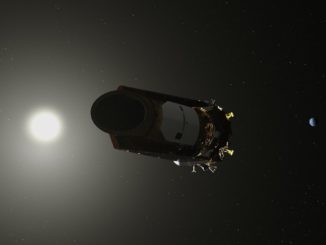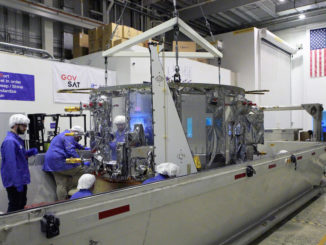STORY WRITTEN FOR CBS NEWS & USED WITH PERMISSION

One week after two cosmonauts and a NASA astronaut arrived at the International Space Station for a six-month stay, the three crew members they’re replacing packed up their Soyuz spacecraft for a fiery plunge back to Earth Wednesday evening to close out a 196-day mission.
NASA astronaut Chris Cassidy, the outgoing commander of Expedition 63, turned the station over to cosmonaut Sergey Ryzhikov Tuesday, handing him a ceremonial “key” to the lab complex. Ryzhikov, Sergei Kud-Sverchkov and Kate Rubins arrived at the station last Wednesday aboard their own Soyuz ferry ship.
“Expedition 63 has gone by super fast,” said Cassidy, a former Navy SEAL. “We joke around that there’s only Mondays and Fridays and it’s a big blur of time between.”
Cassidy’s departure comes less than two weeks before the 20th anniversary of the first station crew’s arrival on Nov. 2, 2000. Since then, the lab has been continuously staffed by rotating international astronaut-cosmonaut crews.
In a tweet Tuesday, Cassidy noted the lab’s first commander was also a veteran SEAL.
“Twenty years ago my astro-SEAL mentor, Captain Bill Shepherd, assumed command of Expedition 1,” Cassidy said. “Now we are book-ending those two decades of manned ISS operations with @us_navyseals astronauts in space.”
It has been an honor to have command of @Space_Station for Expedition 63.
Twenty years ago my astro-SEAL mentor, Captain Bill Shepherd, assumed command of Expedition 1. Now we are book-ending those two decades of manned ISS operations with @us_navyseals astronauts in space. pic.twitter.com/ZJiWd2jtfM
— Chris Cassidy (@Astro_SEAL) October 20, 2020
Cassidy, Soyuz MS-16/62S commander Anatoly Ivanishin and flight engineer Ivan Vagner were launched to the station on April 9. They planned to undock at 7:32 p.m. EDT Wednesday to begin the three-and-a-half hour trip back to Earth and a landing on the steppe of Kazakhstan.
“Mama, I’m coming home!” Vagner tweeted.
‘Mama, I’m coming home!’
Tonight we, the #ISS-63 crew are returning to Earth. This was a busy and very interesting flight! Hope that was interesting!
More detailed — https://t.co/McfMJoEqsv (in English, see the first comment) pic.twitter.com/a8FOC38RCL
— Ivan Vagner (@ivan_mks63) October 21, 2020
After donning their pressure suits and moving a safe distance away from the station, the Soyuz crew planned to monitor an automated 4-minute 40-second rocket firing starting at 10 p.m., slowing the ship by about 286 mph to drop the far side of the orbit into the atmosphere.
Twenty five minutes later, the Soyuz spacecraft’s central crew module was expected to slam into the discernible atmosphere at an altitude of about 62 miles, enduring the scorching heat of re-entry before deploying a large parachute and setting to touchdown near the town of Dzhezkazgan at 10:55 p.m. (8:55 a.m. Thursday local time).
As always, Russian recovery forces, flight surgeons and NASA personnel were deployed near the landing site to help the station fliers out of their cramped descent module as they begin re-adjusting to the unfamiliar tug of gravity after 196 days four hours and 13 minutes off the planet.
After a quick round of medical checks, the crew was to be flown by helicopter to Dzhezkazgan where Cassidy planned to board a waiting NASA jet for the long flight back to Houston. Ivanishin and Vagner were expected to head for Star City near Moscow.
Including two previous flights, Cassidy’s total time in space will total 378 days, moving him up to fifth on the list of most experienced NASA astronauts. Ivanishin, also completing his third flight, will have logged 476 days in space while Vagner was completing his first space flight.
During their stay aboard the space lab, Cassidy’s crew welcomed three unpiloted cargo ships, one Soyuz crew — Ryzhikov, Kud-Sverchkov and Rubins – and the first piloted SpaceX Crew Dragon spacecraft carrying NASA astronauts Douglas Hurley and Robert Behnken.
Cassidy completed four spacewalks during his time aloft, totaling 23 hours and 37 minutes, pushing his overall total to nearly 55 hours across 10 excursions.
Ryzhikov, Kud-Sverchkov and Rubins will have the station to themselves until mid November when NASA plans to launch a three-man one-woman crew to the lab aboard a SpaceX Crew Dragon ferry ship, boosting the station’s crew to seven.



